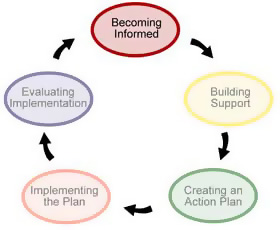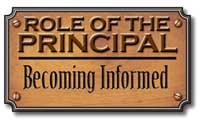What information does Mr. Irwin need to consider before proceeding?
Page 2: Overview of RTI

The first stage of the change process is becoming informed. One of the first things Mr. Irwin does to become informed is attend an informational meeting to learn more about the RTI approach. During this meeting, Mr. Irwin and other principals in the district learn that RTI is a multilevel prevention approach that serves two primary purposes:
early intervening
The delivery of services or assistance to struggling students before they fall too far behind their peers.
Identifying students who have learning disabilities
By facilitating the early identification of students who have learning disabilities, schools that are using the RTI approach may prevent students from experiencing multiple years of failure before they can receive individualized services.
high-quality instruction
High-quality instruction is effective instruction based on research-validated practices.
intervention
An intervention is an instructional technique designed to improve or remediate a certain set of skills.
Whether for early intervening or for identifying students with learning disabilities, RTI always incorporates:
- High-quality instruction
- Frequent progress monitoring
- Increasingly intense levels of instructional intervention
- Data-based decision making
| Universal screening |
|
All students are given a brief screening measure. This assessment is given one to three times per year (i.e., fall, winter, and spring). Students at risk for academic failure are identified. |
| Tier 1 |
|
Students receive high-quality instruction in the general education setting, using validated practices. Teachers frequently monitor the progress (e.g., every one to two weeks) of struggling students who are identified through the universal screening process. (Note: In some approaches, universal screening is considered part of Tier 1.) |
| Tier 2 |
|
Students who are not making adequate progress receive different or additional support from the classroom teacher or another educational professional. Student progress continues to be monitored frequently. |
| Tier 3 |
|
Students whose progress is still insufficient in Tier 2 receive even more intensive and individualized instruction. Depending on a state’s or district’s policies, this instruction may be provided through general education or special education. |
This module describes a three-tiered RTI model. However, some schools may choose to implement an RTI model that includes as many as seven tiers. If you do not already have a comprehensive understanding of the RTI approach, we encourage you to examine the following IRIS Modules:
- RTI (Part 1): Overview
- RTI (Part 2): Assessment
- RTI (Part 3): Reading Instruction
- RTI (Part 4): Putting It All Together
 In the becoming informed stage, principals seek out information about a new approach. They learn as much as they can about the effectiveness of the approach, the benefits for students, and the details of implementation.
In the becoming informed stage, principals seek out information about a new approach. They learn as much as they can about the effectiveness of the approach, the benefits for students, and the details of implementation.